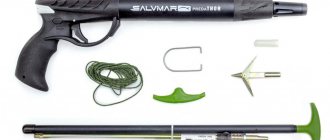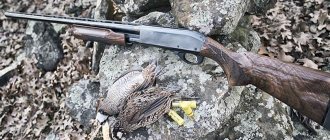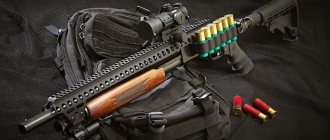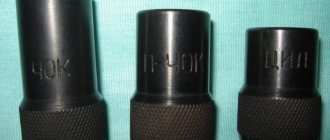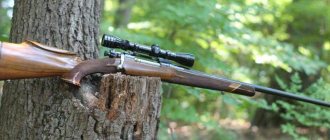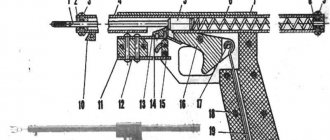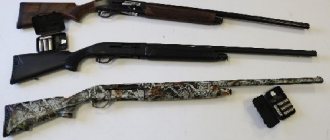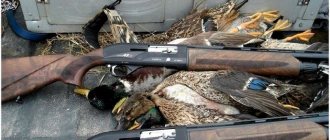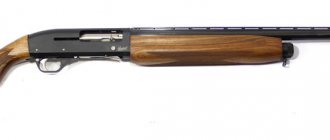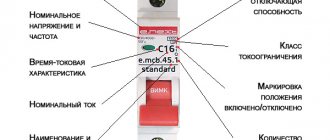An important procedure for a hunter is adjusting the butt of a hunting rifle, which, first of all, allows a novice shooter to improve his hunting results. This article will be useful to both hunters and novice shooters who are to some extent dissatisfied with their shooting results at moving targets.
Fitting the stock consists of the following steps:
- Adjustment of the aiming bar relative to the eye;
- Target shooting;
- Elimination of vertical corrections;
- Elimination of lateral corrections.
The first stage is adjusting the aiming bar relative to the eyes
The bar should be below the pupil, i.e. There should be a small gap between the pupil and the bar. You can shoot when the bar touches the pupil, but this gives a worse result. If the bar covers the pupil, in this case you cannot shoot, because your right eye is covered by the bar and in fact you are shooting with your left eye, that is, at the cross, and as a result you miss.
Vertical butt adjustment
It is necessary to adjust the butt so that when the gun is inserted into the shoulder, the aiming bar is below the pupil with a small gap. How to find out where your bar is? To do this, stand in front of the mirror and make a shotgun, in the reflection of the mirror you will see at what level relative to the eye the aiming bar is located.
The bar is adjusted using the butt comb; it is either raised or lowered. If the bar is at or above the pupil (in most cases), you will need to raise the height of the ridge - the bar will go down. To do this, place a thin layer of foam rubber 1 - 2 mm thick on top of the comb.
If the eye is too open, it is necessary to grind down the butt comb, thereby increasing the height of the bar. But such cases are rare. There are stocks with an adjustable comb - the best option for a novice shooter; there is no need to sharpen or extend anything.
Conclusion:
raising or lowering the aiming bar relative to the eye is carried out by raising or lowering the comb.
Side release of a shotgun stock
The butt of the gun must certainly have a side outlet (to the right of the aiming line), which is necessary for ease of shooting (Fig. 22, 1, a). In this case, the lateral deviation in the toe (see Fig. 22, 2, a2) is greater than in the heel of the butt (see Fig. 22, 2, a1):
this improves the gun's grip. The average size of the stock moving to the side at the heel of the butt is 3-5 mm, at the toe - 5-8 mm. With a large retraction of the stock, the point of impact deviates to the right, with a small retraction - to the left. The end of the butt is usually covered with a pad called the butt plate. This overlay is most often made of plastic, less often of iron or bone. On high-end shotguns they do not put a butt plate, but make a notch on the wood of the butt plate. In recent years, rubber shock absorbers have become widespread throughout the world. Such shock absorbers are installed on domestic shotguns MTs21, TOZ-34, IZH-27, etc.
Rice. 21. Main types of stocks depending on the shape of the neck:
a - straight;
b - half-pistol; c - pistol with a protrusion under the cheek.
An important role is played by the angle between the continuation of the aiming bar and the plane of the butt plate. By placing the gun with the butt plate on the table, you will notice that the barrels either look straight up or are tilted to one side or the other. If the stock is longer to the toe than to the heel, then when the gun is raised, the barrels are directed higher, and if vice versa, lower. Thus, if necessary, the angle of the butt plate can be used to correct the damage of the stock. This can be achieved by changing the shape of the butt plate (Fig. 23).
The second stage is shooting at a target.
You need to take a sheet of A2 size paper, draw a target on it, place it 20 - 30 meters from the shooter and make several shots at the target without aiming, at a glance. Invested - shot, invested - shot.
You need to make from 8 to 12 such shots at one target. This is necessary to understand where the center of the scree is forming. Since the target flies from different directions when hunting, it is better to shoot the combination of shots shown in the figure.
Wiring from bottom to top shot, wiring from left to right shot, etc. A scree will form on which the center of the scree will be formed. It can be centered, top, bottom, right, left, or other combinations. After we have found out where the center of the scree is, we can move on to adjusting the butt to the shooter. If the center of the scree is centered, there is no need to adjust the stock.
The third stage is adjusting the butt vertically
In this case, the center of the scree is either above the target or below the target.
If the scree is below the target, then most likely we do not see the bar, but only see part of the block and a small part of the front sight, perhaps we don’t even see the front sight. Therefore, the shot occurs below eye level and, as a result, the shot falls under the target. The bar is closed.
Adjusting the butt plate - pitch
In this case, it is necessary to open the bar slightly so that the center of the scree goes higher. To do this, you need to place a gasket under the lower part of the butt plate, thereby opening the bar above eye level.
If the center scree forms above the target, then the bar is too open. In this case, it is necessary to close the bar. Place a spacer under the top of the buttplate, thereby lowering the aiming bar. The center of the scree will move down.
Conclusion:
opening or closing the strap is carried out by changing the angle of the butt plate, i.e. pitch change.
content .. 1 2 3 9 ..
CONSTRUCTION AND DIMENSIONS OF HUNTING RIFLES BARRELS
Connecting hunting rifle barrels
. As already mentioned, the barrels of double-barreled shotguns are connected either in a horizontal or vertical plane. Horizontally located trunks are soldered, vertically located ones are either soldered or connected with couplings. Thus, the barrels of IZH-27, TOZ-34, MTs109 (USSR), Merkel-203 (GDR) are soldered; the barrels of IZH-59 “Sputnik”, IZH-56-3 “Belka”, “Olen” (USSR), “Remington-3200” (USA) are connected by couplings.
Double-barrel barrels
Different models are soldered differently. For double-barreled guns with horizontal barrels, for example, by mechanical processing, the under-barrel hooks with the barrels are carefully adjusted to each other, the sighting bar is extended to fit the Greener bolt into its hole, after which all these parts are connected with silver solder at a temperature of 620-650 °. Here it is very important not to go beyond the temperature limits, since if overheated, barrel steel can lose the necessary qualities (strength, toughness); This danger is especially great when using brass solder, the melting point of which reaches 800 °. After this, the aiming bar, the bottom bar and the wedge between the barrels in the area of the muzzle sections are fitted and soldered with soft solder. The melting point of soft solder is approximately 250°.
Sights
can be divided into several main types: sights for shooting shotguns (front sight without a sighting bar, front sight with a sighting bar); ring sights for shooting shot and bullet; open sights for shooting bullets (front and rear sights); optical sights.
On some, most often single-barrel, single-shot shotguns, there is no sighting bar, for example on the IZH-17 and IZH-18. It is very inconvenient to aim with such a gun, since a closely located notch (usually on the gun block) is not clearly visible, so the shooter can make big mistakes when aiming. Previously, self-loading shotguns such as "Browning" (Belgium) had a sighting rib made only for the length of the receiver, but now it occupies the entire length of the barrel. MTs21 (USSR) also has an aiming rib along the entire length of the barrel, with the exception of the section that enters the receiver when the barrel rolls back during a shot.
Among our hunters, the most common are double-barreled smoothbore shotguns with an aiming rib (ventilated or solid) soldered to the barrels. The planks can be narrow and wide, straight and concave. The upper surface of the bar is covered with fine corrugation (guilloche) to prevent reflection of light rays, which greatly interfere with aiming. The front sight on the sighting bar is usually installed on a thread near the muzzle and is made in the form of a brass ball. Some hunters prefer an ivory front sight, which is more visible when shooting at dusk.
When shooting a shotgun with a bullet, it is advisable to have a rear sight with a wide semicircular slot. It is made permanent (non-reclining) and does not interfere with shot shooting. The rear sight must be installed at such a distance from the eye that when aiming the slot is clearly visible. Since people's vision is different and changes with age, the rear sight is usually placed in the middle between the eye and the front sight. In order to clearly see the outline of the rear sight slot, it should be slightly expanded towards the front sight. All this, naturally, applies to sights mounted on rifled weapons.
Open sights on rifled weapons have a rear sight and a front sight and are mounted on the barrel. For shooting at long distances or with cartridges with a steep bullet trajectory, the rear sights have devices for lifting them or changing slotted shields. For shooting in low light conditions, it is better to make the edges of the rear sight slot and the front sight itself white. With cartridges with a flat bullet trajectory, it is enough to have one rear sight position designed for a distance of approximately 150 m. When shooting
at 200 m you can slightly raise the aiming point. For shooting at longer distances, only one thing can be recommended: use an optical sight with 4- or 6-fold magnification.
It makes sense to install optical sights on smooth-bore guns only in the following cases: with frequent ambush hunting of ungulates at dusk or other unfavorable lighting conditions; with significant visual defects.
Ring sights are very good for smooth-bore weapons. They are installed on the neck of the stock near the hunter's eye, which lengthens the aiming line. The ring sight folds easily and therefore does not interfere with shot shooting. When aiming, the hunter looks through the ring and places the front sight in the center. The ring practically does not cover the target and makes it possible to easily select the required lead. By the way, the ring itself helps to more correctly determine the required amount of lead. In addition, attention or vision is focused only on the target and the front sight, without being distracted by the unclear circle of the sight hole. Typically, such a sight has two replaceable rings - with a diameter of 3.2 and 4 mm. With some training, the ring sight significantly improves the accuracy of shooting at dusk, at a moving target and, of course, when firing a bullet at an animal from a smooth-bore weapon.
In addition to sighting devices, the barrels have under-barrel hooks; a device that either pushes the cartridges out of the chamber (extractor) or throws them out (an ejector, sometimes located in the forend); hook for attaching the forearm; swivel (the other is attached to the butt). There are guns that do not have swivels.
content .. 1 2 3 9 ..
The fourth stage of adjusting the butt horizontally.
When the center of the scree has formed to the right or left of the target.
What flies to the left of the target must be straightened to the right, and what is flying to the right must be shifted to the left. To understand why this happens, look at the picture.
- The scree goes to the left (Figure A), the ridge must be moved to the right.
- The scree goes to the right (Figure B), the ridge must be moved to the left.
How to do it? If the comb is not adjustable, in case “A” it is necessary to grind off the butt comb on the left side, and in case “B”, on the contrary, stick something on: double-sided tape, foam rubber, electrical tape. If the stock comb is adjustable, then move the comb in the direction you need.
Conclusion:
To adjust the center of the scree left or right, you need to adjust the comb either left or right.
There are also combinations of adjustments up to the right, down to the left, etc. In this case, it is necessary to combine the third and fourth stages of adjusting the stock.
So, we looked at the four stages of adjusting the butt of a gun to suit you (the shooter). This technique allows the hunter to make do-it-yourself stock adjustments, which will ultimately improve your hunting results.
Getting to know the "vertical"
The 32 caliber Deer shotgun (photo of the shooting model is presented in the article) is a double-barreled combined hunting weapon. Due to the fact that the trunks in it are located vertically, hunters also call it “vertical”. The basis for the creation of the “Deer” gun was the single-barrel trigger model ZKM-1, designed by designer V.A. Kazansky and produced at the same ZMZ plant. Unlike the ZKM-1, the block in the “Deer” gun has two barrels. In addition, this model has a larger block and a redesigned trigger mechanism. These small arms belong to a rather interesting and independent type of hunting weapon. In 1950, an ordinary “Deer” cost 560 rubles. On order, a rifle unit could be purchased for 625.
